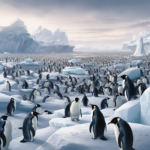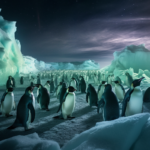Penguins, with their adorable waddle and distinctive tuxedo-like appearance, have captured the hearts of many people around the world. These fascinating creatures, found primarily in the Southern Hemisphere, have a unique way of interacting with humans. Whether it’s through encounters in zoos and aquariums or in their natural habitats, penguins have shown a remarkable ability to engage with humans in various ways. In this article, we will explore how penguins interact with humans, from their curious nature and social behavior to their reactions to human presence and the efforts made by humans to protect and conserve these beloved creatures. So, let’s dive into the world of penguins and discover the captivating ways in which they interact with us.
Key Takeaways
- Penguins can interact with humans in controlled environments such as zoos and aquariums.
- Human interaction with penguins should be limited to avoid causing stress or harm to the animals.
- Proper education and guidelines are necessary to ensure the well-being of both penguins and humans during interactions.
- Penguins may exhibit curiosity towards humans but should be respected and observed from a safe distance.
- Conservation efforts and responsible tourism can help protect penguin populations and their natural habitats.
Understanding Penguin Behavior: Interaction Among Penguins
A. How Penguins Communicate with Each Other
Communication plays a vital role in the social interactions of penguins. Although they cannot speak like humans, these fascinating creatures have developed various ways to convey messages to one another. Penguins primarily rely on vocalizations, body language, and displays to communicate within their colonies.
-
Vocalizations: Penguins produce a wide range of vocal sounds, each serving a different purpose. For instance, during courtship, males often emit a distinct call to attract a mate. This call is unique to each individual, acting as a form of identification. Additionally, penguins use vocalizations to establish territory boundaries, locate their partners or chicks in crowded colonies, and warn others of potential threats.
-
Body Language: Penguins are skilled at using body language to express their intentions and emotions. They can communicate through various gestures, such as head bobbing, flapping their flippers, or bowing. These movements convey messages related to courtship, aggression, submission, or bonding. For example, a penguin may bow its head and extend its flippers to display submission, while an aggressive penguin may raise its head high and make itself appear larger.
-
Displays: Penguins also engage in elaborate displays to communicate with their peers. One well-known display is the “ecstatic display,” where a penguin stretches its head and neck upwards, flaps its flippers, and emits a loud call. This display is often performed during courtship or to reinforce pair bonding. Another display, called the “head-turning display,” involves a penguin turning its head from side to side to establish dominance or territorial boundaries.
B. The Role of Play in Penguin Interactions
Play is an essential aspect of penguin interactions, serving multiple purposes within their social dynamics. Play behavior is commonly observed among penguin chicks, but adult penguins also engage in playful activities.
-
Social Bonding: Play provides an opportunity for penguins to strengthen social bonds within their colony. Chicks engage in playful interactions, such as chasing each other, sliding on their bellies, or engaging in mock fights. These activities help them develop social skills, establish hierarchies, and form lasting relationships with their peers.
-
Physical Fitness: Playful behaviors also contribute to the physical fitness of penguins. Sliding on their bellies, for example, helps them improve their swimming and diving skills. These activities allow penguins to practice essential movements and build strength, ultimately enhancing their ability to forage for food and evade predators.
-
Stress Relief: Play can serve as a form of stress relief for penguins. Living in challenging environments, such as the Antarctic, can be demanding. Engaging in playful activities helps penguins alleviate stress and maintain their overall well-being.
C. Cooperation Among Penguins: Working Together for Survival
Cooperation is crucial for penguins, as it enhances their chances of survival in harsh environments. Penguins exhibit remarkable teamwork and cooperation in various aspects of their lives.
-
Huddling: One of the most striking examples of cooperation among penguins is huddling. Penguins gather in large groups, forming tightly packed clusters to conserve heat and protect themselves from extreme cold. By huddling together, they create a microclimate that helps them withstand the frigid temperatures of their habitats.
-
Feeding: Penguins often work together when it comes to feeding. They form groups and swim in unison, herding schools of fish or krill towards the surface. This cooperative hunting strategy increases their chances of catching prey and ensures a more efficient utilization of resources.
-
Parental Care: Penguins also demonstrate cooperation in raising their young. Both parents take turns incubating the eggs and caring for the chicks. This shared responsibility allows them to forage for food while ensuring the survival and well-being of their offspring.
In conclusion, penguins have developed intricate ways to interact with one another. Through vocalizations, body language, and displays, they communicate their intentions and emotions. Playful interactions contribute to social bonding, physical fitness, and stress relief. Moreover, cooperation among penguins is evident in huddling for warmth, cooperative feeding, and shared parental care. Understanding these aspects of penguin behavior helps us appreciate their remarkable adaptability and resilience in their natural habitats.
Penguins and Their Environment: A Complex Relationship

A. How Penguins Interact with Their Natural Habitat
Penguins have a fascinating relationship with their natural habitat, which primarily consists of icy regions such as Antarctica and the surrounding sub-Antarctic islands. These flightless birds have evolved to thrive in some of the harshest conditions on Earth, showcasing remarkable adaptations that allow them to survive and interact with their environment.
-
Physical Adaptations: Penguins have a streamlined body shape, which enables them to move effortlessly through the water. Their wings have evolved into flippers, perfect for propelling them through the icy depths. Additionally, their dense feathers provide excellent insulation, keeping them warm in freezing temperatures.
-
Feeding Habits: Penguins are primarily carnivorous and rely on the rich marine life found in their habitat for sustenance. They have developed specialized beaks that allow them to catch and consume fish, krill, and squid. Some penguin species, like the Emperor penguin, can dive to incredible depths of over 500 meters in search of food.
-
Nesting and Breeding: Penguins exhibit fascinating nesting behaviors. They form large colonies, with some colonies consisting of thousands or even millions of individuals. These colonies serve as protection against predators and provide a sense of community. Penguins build nests using rocks, pebbles, and other materials to keep their eggs and chicks safe from the icy ground.
B. Interaction of Penguins with Other Species
Penguins share their habitat with various other species, and their interactions can be both cooperative and competitive. Here are a few examples:
-
Predators: Penguins face threats from predators such as leopard seals, killer whales, and skuas. These predators often target penguins during their vulnerable moments, such as when they are on land or swimming near the surface. Penguins have developed strategies to evade these predators, including forming tight groups and using their agility to escape.
-
Marine Life: Penguins coexist with a diverse range of marine life, including fish, seals, and whales. While some species of fish and squid are prey for penguins, others compete for the same food sources. This competition for resources can sometimes lead to conflicts between penguins and other marine species.
-
Human Interaction: Penguins have also interacted with humans, particularly in regions where tourism and research activities take place. Scientists conduct studies to better understand penguin behavior, monitor their populations, and assess the impact of human activities on their habitat. Responsible wildlife tourism operators follow strict guidelines to minimize disturbance to penguins and their environment.
C. The Impact of Environmental Changes on Penguins
Penguins are highly vulnerable to environmental changes, and their populations can be significantly impacted by shifts in their habitat. Here are a few key factors:
-
Climate Change: The warming of the Earth’s climate has led to the melting of sea ice, which is crucial for penguins’ breeding and foraging activities. As the ice retreats, penguins may have to travel longer distances to find food, putting additional strain on their energy reserves. Changes in ocean currents and temperatures can also affect the availability of prey species.
-
Pollution: Pollution, particularly oil spills, can have devastating effects on penguins and their habitat. Oil can coat their feathers, impairing their insulation and making them susceptible to hypothermia. It can also contaminate their food sources, leading to long-term health issues.
-
Overfishing: Overfishing can deplete the fish stocks that penguins rely on for food. When the availability of prey decreases, penguins may have to travel farther or switch to less nutritious food sources, which can impact their overall health and reproductive success.
Understanding the complex relationship between penguins and their environment is crucial for their conservation. Efforts to protect their habitats, reduce pollution, and mitigate the impacts of climate change are essential to ensure the survival of these remarkable birds in the face of ongoing environmental challenges.
The Human-Penguin Connection: An Intriguing Interaction

A. How Emperor Penguins Interact with Humans
Emperor penguins, the largest of all penguin species, have captivated the human imagination for centuries. These majestic creatures, known for their resilience and unique breeding habits, have also been the subject of numerous scientific studies and documentaries. But what is it like to interact with these incredible birds up close?
Emperor penguins are primarily found in the Antarctic region, where they brave the harsh conditions of the icy continent. While it may seem unlikely for humans to encounter these penguins in their natural habitat, there have been instances where researchers and explorers have had the privilege of observing and interacting with them.
During Antarctic expeditions, scientists and explorers have had the opportunity to closely observe emperor penguins in their colonies. These interactions have provided valuable insights into their behavior, feeding habits, and social dynamics. Researchers have been able to witness the incredible teamwork displayed by these birds as they huddle together to withstand the extreme cold.
It’s important to note that when interacting with emperor penguins, it is crucial to follow strict guidelines to ensure minimal disturbance to their natural behavior. Researchers and explorers must maintain a respectful distance and avoid any actions that may cause stress or harm to the penguins or their environment. This includes refraining from touching or feeding the penguins, as well as avoiding loud noises or sudden movements.
B. The Unique Interaction of African Penguins with Humans
While emperor penguins may be the stars of the Antarctic, African penguins have their own unique interaction with humans. These charismatic birds, also known as jackass penguins due to their distinctive braying call, are found along the coastlines of South Africa and Namibia.
One of the most notable aspects of the interaction between African penguins and humans is the presence of penguin colonies near urban areas. In some places, such as Boulders Beach in South Africa, penguins have made themselves at home amidst human settlements. This proximity has allowed for a fascinating coexistence between humans and penguins.
Tourists and locals alike flock to these areas to catch a glimpse of these adorable creatures in their natural habitat. Boardwalks and viewing platforms have been constructed to provide visitors with a safe and non-intrusive way to observe the penguins. This careful planning ensures that the penguins’ natural behavior is not disrupted while still allowing humans to appreciate their presence.
C. Can Penguins Understand Humans?
One question that often arises when discussing human-penguin interactions is whether penguins can understand humans. While penguins do not possess the same level of cognitive abilities as humans, they are highly perceptive creatures and can respond to certain human behaviors.
For example, penguins have been observed to react to the presence of humans by altering their behavior. In some cases, they may become more cautious or retreat to a safer distance. This suggests that penguins are aware of human presence and can adjust their behavior accordingly.
However, it is important to remember that penguins are wild animals and should be treated as such. While they may display curiosity or interest in humans, it is crucial to respect their boundaries and avoid any actions that may cause distress or harm. This includes refraining from approaching or touching the penguins without proper authorization or guidance.
In conclusion, the interaction between humans and penguins is a fascinating aspect of wildlife conservation and research. Whether it’s the awe-inspiring encounters with emperor penguins in the Antarctic or the unique coexistence with African penguins along the coastlines, these interactions provide valuable insights into the behavior and conservation needs of these incredible birds. By following wildlife interaction guidelines and promoting responsible tourism, we can ensure the protection and preservation of penguins and their habitats for future generations to enjoy.
The Penguin Perspective: How Penguins Perceive Humans

A. How Penguins See Humans
Penguins, with their unique adaptations and behaviors, have captivated the interest and curiosity of humans for centuries. But have you ever wondered how penguins perceive us? While we may never truly know what goes on in a penguin’s mind, we can gain some insights into their perspective.
Penguins primarily rely on their vision to navigate their surroundings and interact with their environment. Their eyes are specially adapted to see underwater, allowing them to spot prey and predators while swimming. However, their vision on land is not as sharp as it is underwater.
When it comes to humans, penguins may perceive us as large, looming figures. They might see us as potential threats or predators, especially if we approach them too closely or make sudden movements. It’s important to remember that penguins are wild animals, and they have a natural instinct to protect themselves and their young.
B. Penguins’ Reaction to Human Presence
Penguins have evolved in remote and isolated environments, where encounters with humans were rare until recent times. As a result, their reactions to human presence can vary depending on the species and their level of exposure to human activities.
In areas where penguins have had little or no contact with humans, they may exhibit a curious but cautious behavior. They might approach humans with a mix of curiosity and wariness, often observing from a safe distance. This behavior is particularly common in locations where penguins have not been extensively studied or where human presence is strictly regulated, such as in protected reserves or remote Antarctic regions.
On the other hand, penguins that inhabit areas frequented by humans, such as popular tourist destinations or research stations, may display a different response. These penguins have become accustomed to human presence and may show less fear or hesitation. They might even approach humans out of curiosity, especially if they have learned to associate humans with food.
It’s important to note that while penguins may seem friendly or approachable, it is crucial to respect their space and not disturb their natural behaviors. Getting too close, making loud noises, or attempting to touch them can cause stress and disrupt their daily routines. As responsible visitors, we must prioritize the well-being and conservation of these incredible creatures.
To ensure a positive human-penguin interaction, various guidelines and regulations have been established in wildlife tourism and research programs. These guidelines aim to protect the penguins’ natural habitats and minimize the impact of human activities. By following these guidelines, we can enjoy observing penguins in their natural environment while ensuring their safety and well-being.
In conclusion, understanding how penguins perceive humans can help us foster a respectful and responsible approach when interacting with these fascinating creatures. By maintaining a safe distance, observing quietly, and adhering to wildlife interaction guidelines, we can appreciate the beauty of penguins while ensuring their conservation for future generations to enjoy.
The Impact of Human Activity on Penguins
A. How Human Activities Affect Penguins
Penguins, with their adorable waddle and distinctive black and white plumage, have captured the hearts of people around the world. However, human activities can have a significant impact on these fascinating creatures and their delicate ecosystems. Let’s explore some of the ways in which human actions affect penguins.
1. Habitat Destruction
One of the most significant threats to penguins is habitat destruction. Human activities such as pollution, oil spills, and coastal development can disrupt their nesting sites and feeding grounds. Penguins rely on specific habitats, such as rocky shores and ice shelves, to breed and raise their young. When these habitats are destroyed or altered, it can have devastating consequences for penguin populations.
2. Climate Change
Climate change is another major concern for penguins. Rising temperatures and melting ice in polar regions directly impact their natural habitats. Penguins, especially those in Antarctica, depend on sea ice for hunting and breeding. As the ice melts, it becomes more challenging for them to find food, and their breeding cycles are disrupted. Changes in ocean currents and sea temperature can also affect the availability of prey species, further impacting penguin populations.
3. Overfishing
Overfishing is a global issue that affects not only penguins but also many other marine species. Penguins rely on fish and krill as their primary food sources. However, excessive fishing can deplete these resources, leaving penguins struggling to find enough food to survive. It is crucial for humans to practice sustainable fishing methods to ensure the long-term survival of penguin populations.
B. The Role of Humans in the Changing Penguin Environment
While human activities have undoubtedly had a negative impact on penguins, humans also play a vital role in protecting and conserving these remarkable creatures and their habitats. Here are some ways in which humans can contribute to the well-being of penguins.
1. Conservation Efforts
Numerous organizations and researchers are dedicated to studying and conserving penguins. Through scientific research and monitoring programs, we can better understand penguin behavior, habitat requirements, and population dynamics. This knowledge is crucial for developing effective conservation strategies and implementing measures to protect penguin habitats.
2. Wildlife Tourism
Responsible wildlife tourism can provide economic incentives for local communities to protect penguin habitats. By promoting sustainable and penguin-friendly tourism practices, we can ensure that visitors have the opportunity to observe these incredible creatures without causing harm. Strict guidelines should be in place to minimize disturbance to penguins and their habitats, such as maintaining a safe distance and avoiding direct contact.
3. Education and Awareness
Raising awareness about the importance of penguins and their conservation is essential. By educating the public about the threats facing penguins and the actions they can take to help, we can inspire individuals to make a positive difference. This can include supporting conservation organizations, reducing our carbon footprint, and making sustainable choices in our daily lives.
In conclusion, human activities have both positive and negative impacts on penguins. While habitat destruction, climate change, and overfishing pose significant challenges, humans also have the power to protect and conserve these incredible creatures. By understanding the effects of our actions and taking steps to minimize harm, we can ensure a brighter future for penguins and their fragile ecosystems. Conclusion
In conclusion, penguins have a unique and fascinating way of interacting with humans. Whether it’s through their playful behavior, their curious nature, or their ability to form strong bonds, these incredible creatures have managed to capture the hearts of people all around the world. From encounters at zoos and aquariums to expeditions in the wild, humans have been fortunate enough to witness firsthand the charm and charisma of these flightless birds. Penguins have shown us that despite our differences, we can still find common ground and form connections with other species. As we continue to learn more about these remarkable creatures, it is important that we strive to protect their natural habitats and ensure their survival for generations to come. So, the next time you have the opportunity to interact with a penguin, cherish the moment and appreciate the beauty of this extraordinary relationship between humans and these captivating birds.
Frequently Asked Questions
How do penguins interact with each other?
Penguins interact with each other through a variety of vocal and physical behaviors. They use calls to identify their mates and chicks among the large colonies. Physical interactions include preening, pecking, and flipper patting, which are used for social bonding and establishing dominance.
How do penguins communicate with humans?
Penguins do not communicate with humans in the same way they communicate with each other. However, they can recognize and respond to human behaviors. For example, in a zoo setting, they may associate the presence of their keepers with feeding times.
Can penguins understand humans?
While penguins can recognize and respond to certain human behaviors, there is no evidence to suggest that they can understand complex human language or commands. Their responses are more likely based on learned associations rather than understanding.
How do penguins interact with their environment?
Penguins interact with their environment in several ways. They use their physical adaptations, such as their wings and feet, to navigate in water and on land. They also interact with their environment through their feeding habits, often diving deep into the ocean to catch fish and squid.
How do emperor penguins interact with humans?
Emperor penguins are not typically exposed to humans due to their remote Antarctic habitat. However, when they do encounter humans, such as researchers or tourists, they tend to be curious but cautious. It’s important for humans to respect their space and not disrupt their natural behaviors.
How do penguins play with each other?
Penguins often engage in playful behaviors with each other, especially as juveniles. This can include chasing each other in the water, sliding on their bellies on the ice, and play-fighting, which helps them develop the skills they need for survival.
How do penguins talk to each other?
Penguins communicate with each other primarily through vocalizations, known as calls. Each penguin has a unique call that allows it to be recognized by its mate and chicks. They also use body language and physical interactions to communicate.
Do penguins work together?
Yes, penguins often work together for survival. For example, Emperor penguins huddle together in large groups to share warmth and protect against the harsh Antarctic weather. Penguins also work together when hunting, using coordinated efforts to catch their prey.
How do penguins help each other?
Penguins help each other in several ways. They share parenting duties, with both parents taking turns incubating the eggs and feeding the chicks. In harsh conditions, they huddle together to share warmth. They also display cooperative hunting behaviors.
How do penguins react to humans?
Penguins’ reactions to humans can vary depending on their experiences and the species. Some penguins, particularly those in zoos or rehabilitation centers, may be accustomed to human presence. Wild penguins may react with curiosity or caution. It’s important for humans to respect penguins’ space and not disrupt their natural behaviors.




